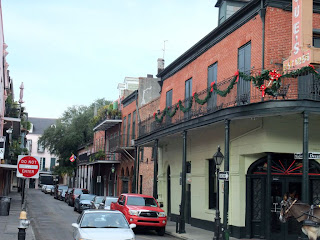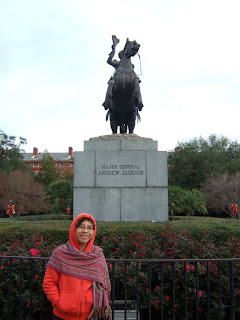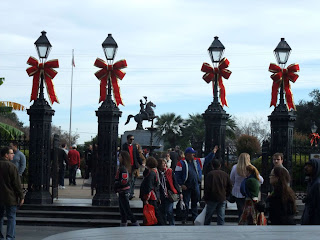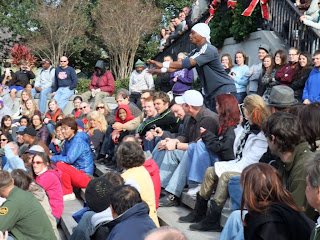
French Quarter, also known as Vieux Carre' in French which means old square, is the oldest neighborhood in New Orleans. It is the most famous and most visited section of the city. When New Orleans was found in 1718 by French Canadian naval officer, Jean Baptiste Le Moyne de Bienville, the city was originally center on French Quarter. In 1762 the indifferent Louis XV transferred Louisiana to his Bourbon Cousin Charles III of Spain and Spanish rule lasted for 4 decades. The colony was sold to united States in 1803 after signing the Louisiana Purchase. An era of prosperity inaugurated but the influences of American culture was slow due to the arrival of 10 thousand refugees from French-Haitian Revolution and Napoleonic Wars. The glorious victory of 1815 Battle of New Orleans against British forces, finally fixed the loyalty to American Nation. French Quarter's golden era followed as cotton, sugar and steamboats poured into the city. American, Irish, German, African, foreign French immigrants swelled the population, creating a heterogeneous matrix of culture, language, religion and cuisine. Civil War and reconstruction played out politically on the streets of French Quarter put an end to its prosperity. As Old Square declined Creoles moved to Esplanade and later Uptown and the grand space of French Quarter mansions of 1890's was found cramped lodging by Sicilian (southern Italian) immigrants. The district as a whole is a national historic landmark and contains numerous individual historical buildings.
French Quarter sits 5 feet above sea level and was built on dry land that predated New Orleans's levee systems. During the disaster of Hurricane Katrina in year 2005, it was affected relatively light, compared to other areas of the city and other region. Most of the major landmarks and historic site suffered only minor damages.



From street to street, the web of iron-work runs from house to house, balcony to balcony. It wreathes the slender pillars, it sheathes the upper windows and it crests the high brick garden wall. The old Creole builders lavishly made use of wrought metal turning the old square into a town of iron lace.



The horse carriage and the elaborate ironworks and galleries on the corner of Royal and St Peter Street.


French Quarter was officially designated as a national historic landmark in December 1965. The national landmark is stated to be 8589 buildings and most of the architecture was built during the time when Spanish ruled over New Orleans in 18th century.



Most buildings in French Quarter are in multiple architecture reflecting Spanish colonial period of the city. The city remains as a combination of residential, hotels, guest houses, bars and tourist oriented commercial properties.


Before civil war, French Creoles becomes minority in French Quarter and many immigrants from southern Italy and Ireland moved in and settled here during 19th century.



Most of the colonial buildings built in 1734 were destroyed by fire in 1788 and 1794. Buildings were rebuilt again to more modern taste and with strict new fire codes. Old French peaked roofs were to be replaced by flat tiles and banned wooden siding with fire resistant plaster and painted in fashionable pastel hue.



Colorful walls and roofs with elaborately decorated iron work balconies and galleries flourished from both 18th to early 19th century.




Since 1920s historical buildings have been protected by law and cannot be demolished. Any renovation or new construction in the neighborhood must be done according to regulation to match the period historic architectural style.


The French period legacy endures in the town plan and central square, Church of St Louis, Ursuline Convent Woman's education, and also these ancient regime street names.




Live music has been a regular feature of the entire French Quarter including Jackson Square for a century. Formal concerts do take place but very rare. Musician are known to play for tips.



Street performers



Many of today's culinary tradition in French Quarter is Creole as the culture and its cuisine already flourishing by the time Louisiana was purchased over by United States in 1803. Creole were people originally in New Orleans from its founding, who has a mixture of influences in French, German, Spanish with strong west-African foundation. Do not look too hard for healthy food in French Quarter's culinary delight, but it has good food for people of any type in any budget.


The seafood platter, barbecue shrimp and crawfish etouffee are the specialties from Deanies Restaurant.



Strolling through the narrow streets by your two feet or riding on a yellow trishaw as an alternative.


Canal Street had been re-developed by the time the architectural preservation was considered. A live street advertisement of red bull on a little cooper!



The Spanish imparted a legacy of semi-fortified street-scape, common wall plastered brick houses, wall courtyards, graceful wrought iron balconies, hinges and locks in curvilinear shapes.



The Street, Rue Bourbon was named after the former royal family of France. It is steeped in history, folk lore and beauty dating back to 1718 when it was found. It is very famous for its drinking establishments.. New Orleans and its French Quarter are one of the only two places in United States where possession and consumption of alcohol in open containers is allowed on the street. There are a number of notable bars with interesting histories like The Old Absinthe House who has kept its name even though for almost a century, absinthe was illegal in United States.


Bourbon Street comes alive at night particularly during New Orleans Festival like Mardi Gras World. Along the entire street, there are restaurants, bars, souvenir shops, strip clubs and gay bars and many other kinds of entertainments.



Bourbon Street was located at the center of French Quarter extending 13 blocks from Canal Street to Esplanade Avenue. At the center of French Quarter there are also many long history churches like St Augustine Church, Our Lady of Guadalupe Chapel and Old Ursuline Convent.




French Quarter is an interesting place not only for young ones but also for senior people like me.


A real window shopping.



Many of the French Quarter's 1890's mansion had turned into commercial purposes.


Arts galleries in French Quarter.




There is no place like French Quarter ! It is a true venue for party of the world.




Po-boy was derived from the name poor boy as sandwiches were traditionally given to poor street boys by the nuns in New Orleans. A New Orleans sandwich actually is similar to a sub sandwich and they could be made of anything. A typical sandwich of New Orleans are made in a type of meat and dressing with lettuce, tomato, pickles and sauce.



Mother's Restaurant is very well known for their debris po-boy made with debris from a toast which fall into gravy when a toast is cut. The stuffing in between could be kinds of meat or seafood like shrimp, oyster or fish


Unique sign!



When French Creole started moving out of French Quarter in late 19th, immigrants from southern Italy and Ireland flocked in and occupied the grand space of these mansions built in 1890s.


Louisiana Creole Cuisine is a style of cooking originated in Louisiana that blends French, Spanish, Portuguese, Italian, African, Native American influences with American southern cuisine. The little restaurant Coop's Place offered a very traditional Creole dishes and customers were served under a very homely environment. Food prepared and offered were all in Creole tradition and very tasty.



Among all, Gumbo, Jambalaya and Creole must not be missed. Gumbo which means okra is a tasty Louisiana traditional stew, served with rice. It is a dish of meat or seafood stewed in vegetable base in okra and thickened by sassafras leaves, originated from Africa.



When coming to south, many tourists center their visit at French Quarter. There are many old-line restaurants along with music clubs, museum, antique shops and drinking establishments.



Many restaurants ranging from formal to casual patronized by visitors and locals have been in business since 19th century. Court of Two sisters is among the top five and they are very popular for offering brunch with authentic dishes.



The horse carriage at St Peter Street where I had my heaviest breakfast ever at Old Coffee Pot Restaurant and served by this happy senior lady.



Old Coffee Pot Restaurant at St Peter Street Restaurant started business since 1894, offering best breakfast in town. All servers are elderly females seniors who we believed must be working here since young.



The breakfast that offered from Old Coffee restaurant include traditional Creole breakfast like Egg Sardou, calas and grits with craw fish or shrimp and typical American Southern breakfast. Though quite costly but it is heavy enough for you to stand after lunch.




French Quarter has charted a course of urbanism for parts of 4 centuries.


Most of the structures were constructed during the Spanish period and this is reflected in its architecture.








Decatur Street locates near Mississippi River was formerly known as Levee Street. It was named after Stephen Decatur.


For about a century, upper Decatur Street had many business catering to sailors visiting the port of New Orleans. It was re-developed and became more upscale with commercial business such as House of Blues in late 20th century.


Lower part of Decatur Street has now turned into a center of local punk and goth subculture.



It contains various bars and music venues.







Understand the history of French Quarter.


New Orleans Statue of Jean-Baptiste Le Moyne de Bienville, founder of New Orleans. The Statue was located at Conti Street which is a small triangular park built near north St Peter Street and Decatur Street. The Statue is of a native Indian and a priest and the work shows that Bienville in colonial attire.




Bienville, born in Montreal Canada in 23rd Feb 1680 was a French Canadian Naval officer. He started a settlement called New Orleans on the banks of Mississippi River in March 1718. French Quarter was founded as a military-style grid of 70 squares.



Supreme Court in French Quarter.



From 1920s through 1980s, Jackson Square was known as a gathering place of painters, young art students and caricaturists but in 1990s onwards, the artists were joined by tarot card readers, mimes, fortune tellers and street performers.


Horse carriages.


Incredible, a human live transformer!







The interesting fire hydrant in different color and various shape at any where any corner.



Two sides of Jackson Square were Pontolba Buildings to match the red brick block long 4-storey buildings built in 1840s. Ground floor house shops and restaurants and upper floors were apartments which are the oldest continuously rented apartment in USA.




The tarot card readers, fortune tellers, mimes and many other interesting people with special ability gathered at Jackson Square corner to offer their unique services.


It was very lucky to have an opportunity to witness a traditional French wedding possession on the street, that still practice today in small villages of France .


It is a tradition French custom for the groom to escort his bride from her home to a wedding chapel in a procession headed by musician. Followed behind the brass band will be the pride with her father and guests and groom with his mother will be at the end of the line.


The customs include that the bride while in the midst of the march, is confronted by a stream of white ribbon that she must cut through in order to continue, symbolizing obstacles that the couple would have to face in their future life together. A square of silk fabric "carre" is held over the head of the couple when receiving the blessing from priests during the end of the ceremony. This is to protect the couple from descending malice or wickedness.



People in French Quarter dance with umbrella, handkerchief or a fan in many of the important occasions or carnivals. In wedding, people also have bridal umbrella and ladies lace parasols to complement the occasion. Symbol of southern style, femininity and grace become accessory of choice at wedding.


White and blue are most of the chosen color for French Wedding as white represents joy and blue represents purity.


The advent of umbrella originally as a protector against humid rigors of southern sun has become a popular "uniforms of pride". Design and style of the parasol or umbrella that graced your occasion was often the indicator of societal stature.


The altar inside St Louis Cathedral is baroque containing a beautiful tabernacle crafted in Belgium. Baroque interiors was very popular in 1850's France.



The ceiling is adorned in frescoes encased in decoration.





St Louis Cathedral is located on a promenaded section of Charles Street, facing Mississippi River and next to Jackson Square. The site was the heart of the city during colonial era.

St Louis Cathedral with Cabildo, the old city hall to its left and Presbytere, the priest house to its right, are the three 18th century historic buildings, locating just at the opposite side of Jackson Square.


The Cabildo, one of the most significant building in United States, was built in 1795-1799 to replace a structure that burned down in 1794's fire. Cabildo was the location where Louisiana Purchase was signed in 1803. It served as the seat of Government during Spanish colonial period. This old city hall now has become a museum.
Presbytere was built to match Cabildo and originally intended to house the city's Roman and Catholic priests and authorities but was turned into a courthouse in early 19th century. It was then converted into a museum in 20th century and now it houses an elaborate and exquisite collection of Mardi Gras World artifacts and memorabilia.


Cathedral-Basilica of Saint Louis King of France is the official name of St Louis Cathedral. It is the seat of Roman Catholic Archdiocese of New Orleans and has been the distinction of being the oldest continuously operating Cathedral in United States.


St Louis Cathedral was designated a minor basilica by Pope Paul VI. First church on site was built in 1718. It was raised to Cathedral rank in year 1793 and by 1850s, it was rebuilt and largely expanded to a total of 1789 structures but with little remaining today.



Abundant palm trees and its rare flowers at Jackson Square.



Next to Jackson Square at a promenaded section of Charles Street is the site of St Louis Cathedral.


An equestrian statue of Andrew Jackson in the center of the park. Andrew Jackson is the general who lead in the Battle of New Orleans against British Forces and gained the victory.




St Louis Cathedral is one of the few Roman Churches in United States that fronts a major public square.


St Jackson Square is an open park to size of a city-block located at the center of French Quarter, named after a Victorian General Andrew Jackson after the battle of New Orleans. The original name was Place of d'Armes.


Watching street performance.



This performer is a born joker. He made fun over people passing by and create joke over them. Most audiences enjoy his humor.


Many audiences were generous to pay these street performers some tips as they said "help us to sustain a living so that we do not need to climb over the roof and break into your house".


Break Dance!


Maid of Orleans (1412-1431 ) at Place De France next to French Market, was a gift from France and was sent to New Orleans in 1958. It is now permanently erected at the corner of St Philip and Decatur Street, which was the site of fruit complex of French Market and an important part of New Orleans. .


The lovely golden bronze statue of Joan of Arc was a replica of the famous 1880 Emmanuel Fremiet equestrian statue of Joan located at Place des Pyramides, Paris.



The bustling traffic of horse carriages in front of the 19th century Cafe du Monde.


Long queue at Cafe du Monde, diagonally across Jackson Square. Since 19th century, The cafe has been continuously serving its customers until now.



Cafe du Monde opens 24 hours a day, and very well known for its au lait, coffee spiced with chicory and beignets.



It is a custom to blow the powdered sugar into anyone who is the first timer to be there, while making a wish.





French Market, founded in 1791 is the oldest public market in United States.


The open air mall features shopping, dining and music in tradition that is uniquely New Orleans, yet still reminiscent of some European markets.





The masks and party accessories stores. New Orleans is the venue for world party. It takes almost any occasion for an excuse for a parade, a party or a live music. People here are either planning a party, enjoying a party or recovering from one and most of the events often have a touch of Mardi Gras, a world famous festival. Mardi Gras and Jazz Fest bring in millions of tourists to New Orleans annually.



Creole cottages.


French Quarter includes all the land stretching along Mississippi River at east, to the inland from the 79 buildings at North Rampart at west, and from Canal Street at south to the 12 blocks building in Esplanade at north.












